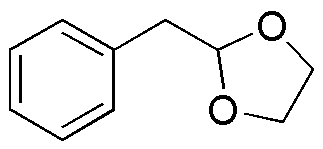2-Benzyl-1,3-dioxolane is widely utilized in research focused on:
- Pharmaceutical Development: This compound serves as a valuable intermediate in the synthesis of various pharmaceutical agents, enhancing the efficiency of drug formulation processes.
- Flavor and Fragrance Industry: Its pleasant aromatic properties make it a popular choice in the formulation of perfumes and flavorings, providing a unique scent profile that appeals to consumers.
- Polymer Chemistry: Used as a monomer or additive, it contributes to the development of specialty polymers, improving material properties such as flexibility and durability.
- Organic Synthesis: The compound is a key reagent in organic synthesis, facilitating the creation of complex molecules in research laboratories, which is crucial for advancing chemical knowledge.
- Cosmetic Formulations: Its stability and skin-friendly properties make it an ingredient in cosmetic products, enhancing texture and scent while ensuring safety for users.
General Information
Properties
Safety and Regulations
Applications
2-Benzyl-1,3-dioxolane is widely utilized in research focused on:
- Pharmaceutical Development: This compound serves as a valuable intermediate in the synthesis of various pharmaceutical agents, enhancing the efficiency of drug formulation processes.
- Flavor and Fragrance Industry: Its pleasant aromatic properties make it a popular choice in the formulation of perfumes and flavorings, providing a unique scent profile that appeals to consumers.
- Polymer Chemistry: Used as a monomer or additive, it contributes to the development of specialty polymers, improving material properties such as flexibility and durability.
- Organic Synthesis: The compound is a key reagent in organic synthesis, facilitating the creation of complex molecules in research laboratories, which is crucial for advancing chemical knowledge.
- Cosmetic Formulations: Its stability and skin-friendly properties make it an ingredient in cosmetic products, enhancing texture and scent while ensuring safety for users.
Documents
Safety Data Sheets (SDS)
The SDS provides comprehensive safety information on handling, storage, and disposal of the product.
Product Specification (PS)
The PS provides a comprehensive breakdown of the product’s properties, including chemical composition, physical state, purity, and storage requirements. It also details acceptable quality ranges and the product's intended applications.
Certificates of Analysis (COA)
Search for Certificates of Analysis (COA) by entering the products Lot Number. Lot and Batch Numbers can be found on a product’s label following the words ‘Lot’ or ‘Batch’.
*Catalog Number
*Lot Number
Certificates Of Origin (COO)
This COO confirms the country where the product was manufactured, and also details the materials and components used in it and whether it is derived from natural, synthetic, or other specific sources. This certificate may be required for customs, trade, and regulatory compliance.
*Catalog Number
*Lot Number
Safety Data Sheets (SDS)
The SDS provides comprehensive safety information on handling, storage, and disposal of the product.
DownloadProduct Specification (PS)
The PS provides a comprehensive breakdown of the product’s properties, including chemical composition, physical state, purity, and storage requirements. It also details acceptable quality ranges and the product's intended applications.
DownloadCertificates of Analysis (COA)
Search for Certificates of Analysis (COA) by entering the products Lot Number. Lot and Batch Numbers can be found on a product’s label following the words ‘Lot’ or ‘Batch’.
*Catalog Number
*Lot Number
Certificates Of Origin (COO)
This COO confirms the country where the product was manufactured, and also details the materials and components used in it and whether it is derived from natural, synthetic, or other specific sources. This certificate may be required for customs, trade, and regulatory compliance.


